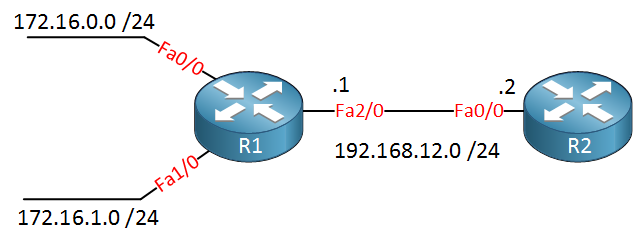In this lesson we’ll take a look at EIGRP summarization. The cool thing about EIGRP and summarization is that it’s easy to do and can be done on the interface level. Here’s the topology that we’ll use:

Let’s create a basic EIGRP configuration:
R1(config)#router eigrp 1
R1(config-router)#no auto-summary
R1(config-router)#network 192.168.12.0
R1(config-router)#network 172.16.0.0R2(config)#router eigrp 1
R2(config-router)#no auto-summary
R2(config-router)#network 192.168.12.0Just a basic EIGRP configuration. This is what the routing table of R2 looks like:
R2#show ip route eigrp
172.16.0.0/24 is subnetted, 2 subnets
D 172.16.0.0 [90/30720] via 192.168.12.1, 00:02:28, FastEthernet0/0
D 172.16.1.0 [90/30720] via 192.168.12.1, 00:02:28, FastEthernet0/0Two entries, as expected. Now let’s create that summary:
R1(config)#interface fastEthernet 2/0
R1(config-if)#ip summary-address eigrp 1 172.16.0.0 255.255.254.0Use the ip summary-address eigrp command to specify the summary. Now the routing table will look like this:



Hello Rene,
I have a question regarding ip summary-address command in above lesson.
By applying ip aummary-address command in fastethrnet 2/0 interface,
how come heart router know about the summary address.
As my understanding ip summary address is per interface basis.
I should apply ip summary-address in fastethernet 1/0 interface.
Would you correct me and help me to understand better.
Thanks.
Hi Toral,
I just changed the picture because the interface number didn’t match. You configure a summary outbound on an interface facing towards your EIGRP neighbor.
Rene
Simple but effective workout to understand EIGRP summerizing
Thanks Django!
thanks for the nice lesson, keep up the good work